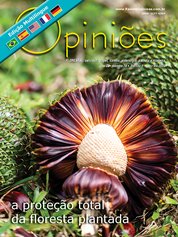James Stahl
Pesquisador em Solos e Manejo Silvicultural na Klabin
OpCP70
Conservando um importante patrimônio: o solo
Em tempos de franca expansão do setor de base florestal e em um cenário de elevados preços de terras, o foco na conservação do solo, aliado à maximização e à manutenção da capacidade produtiva desse recurso, é vital para o sucesso de novos projetos e continuidade dos empreendimentos já instalados.
O solo, que é a base para a produção dos setores de atividades agropecuárias e florestal, associado às práticas de manejo adotadas ao longo dos ciclos de produção, é essencial para promover e garantir um ecossistema produtivo conservacionista e sustentável ao longo tempo.
O setor de florestas plantadas vem evoluindo constantemente nas últimas cinco décadas, na adoção e no uso de práticas conservacionistas no plantio e no manejo de eucalipto e pínus.
Um dos destaques foram as alterações nas atividades do processo de preparação de solo, saindo de um modelo onde se usava a queima de todo tipo de resíduos durante a limpeza da área e a preparação intensiva do solo com aração e gradagem em área total para um modelo de cultivo mínimo com subsolagem na linha de plantio, dessecação da massa vegetal com uso de herbicidas e manutenção de resíduos sobre o solo nas entrelinhas de plantio.
Esses métodos e estratégias de manejo foram apoiados na geração de conhecimento científico e técnico, em parcerias com universidades e institutos de pesquisas nacionais, e no desenvolvimento interno e na aplicação prática dos conceitos pelas empresas do setor, em cada realidade local de solo e clima em que estão inseridos.
Além da mudança no manejo adotado, os investimentos constantes pelas empresas em mapeamentos em uma escala cada vez mais detalhada dos ambientes de produção, como mapeamento de elevação digital do terreno por LiDAR e mapeamento semidetalhado de solo, permitem fazer o uso conservacionista do solo com elevado grau de tecnificação. Os resultados positivos dessas práticas são assegurados pelos crescentes desempenhos em monitoramentos e certificações ambientais que as empresas do setor possuem atualmente.
No contexto da Klabin, que, ao longo da sua história, já faz uso do solo em partes das suas áreas por mais de 60 anos, tanto nas unidades florestais do Paraná como em Santa Catarina, a empresa tem conquistado destaque internacional no manejo florestal utilizado em suas áreas. A companhia é referência mundial no uso de plantios em mosaico, onde mescla uma vasta área de florestas nativas preservadas com plantios de pínus e eucalipto em diferentes idades.
Essa premissa de manejo de utilização de dois gêneros, que exigem práticas de manejo distintas e tem um ciclo de produção diferenciado, sete anos para eucalipto e dezesseis anos para pínus, requer um grande esforço de planejamento estratégico e operacional, para que ocorra a melhor alocação de cada espécie para cada local, ajustada ao balanço de abastecimento da indústria e mantendo o manejo em mosaico.
Esse desafio de equalizar as melhores práticas para atender a essas premissas de manejo resulta em uma série de oportunidades, dentre elas a de se utilizar uma estratégia de rotação de cultura ao longo dos ciclos, entre pínus e eucalipto. O uso alternado do solo, mesmo que por espécie florestais, acaba promovendo inputs diferenciados ao sistema, como ciclagem biogeoquímica distinta, diferentes eficiências no uso de nutrientes do solo, na quantidade e qualidade de resíduos de colheita deixados sobre o solo, assim como diferenças do sistema radicular, entre tantas outras características relacionadas a cada espécie.
Outro ponto a ser destacado é que, no processo de expansão da base florestal, no cenário de ocupação e uso de solo de novas áreas em diversas regiões do País, onde, em sua maioria, se trata da conversão de pastagens para cultura de eucalipto e pínus, resultam, ao final de um ciclo de produção, em ganhos importantes em qualidade ambiental e sustentabilidade. Estudos recentes da Embrapa Florestas demonstram que áreas de pastagens convertidas em plantios de eucalipto apresentam potencial de incremento no estoque de carbono no solo em 11%, na camada de zero a 20 cm, evidenciando a melhora em atributos do solo com a entrada do componente arbóreo, mesmo que para fins industriais.
Outros resultados importantes são obtidos com um conjunto de ações de manejo praticadas ao longo da implantação e condução dos plantios, como a estabilização e recuperação de processos erosivos presentes em alta frequência em áreas de pastagens, descompactação do solo, de forma localizada nas linhas de plantio, e a construção e adequação de rede interna de estradas, com uso de técnicas conservacionistas. Essas práticas somadas, quando bem executadas, reduzem, de forma significativa, as perdas de solo e auxiliam na regulação hidrológica local.
A busca pela manutenção da capacidade produtiva dos solos já ocupados por plantios florestais, que são submetidos constantemente a materiais genéticos altamente produtivos, exige que as práticas de manejo, além de superarem as restrições físicas do solo, promovam uma adequada reposição de nutrientes baseada no balanço de entradas e saídas desses componentes do sistema.
Gerar e fazer o uso de informações de fertilidade do solo das áreas a serem plantadas, assim como uma caracterização da eficiência de uso de nutrientes pelos materiais genéticos, permitem avançar no conhecimento específico da interação solo-planta em cada região, adequando as dosagens necessárias de reposição de nutrientes, de modo a fazer uso eficiente dos insumos e suportar os níveis de produtividades esperados.
Mesmo que a atividade de floresta plantada tenha ciclos de produção de médio e longo prazo e que, atualmente, já se disponha de conhecimento e se faça o uso de práticas conservacionistas no setor, a geração e a implementação contínua das melhores práticas visando à conservação do solo são necessárias e devem ser difundidas, desde os pequenos até os grandes produtores. Dessa forma, a floresta plantada continuará assegurando a perpetuidade de um dos nossos maiores patrimônios, o solo.




